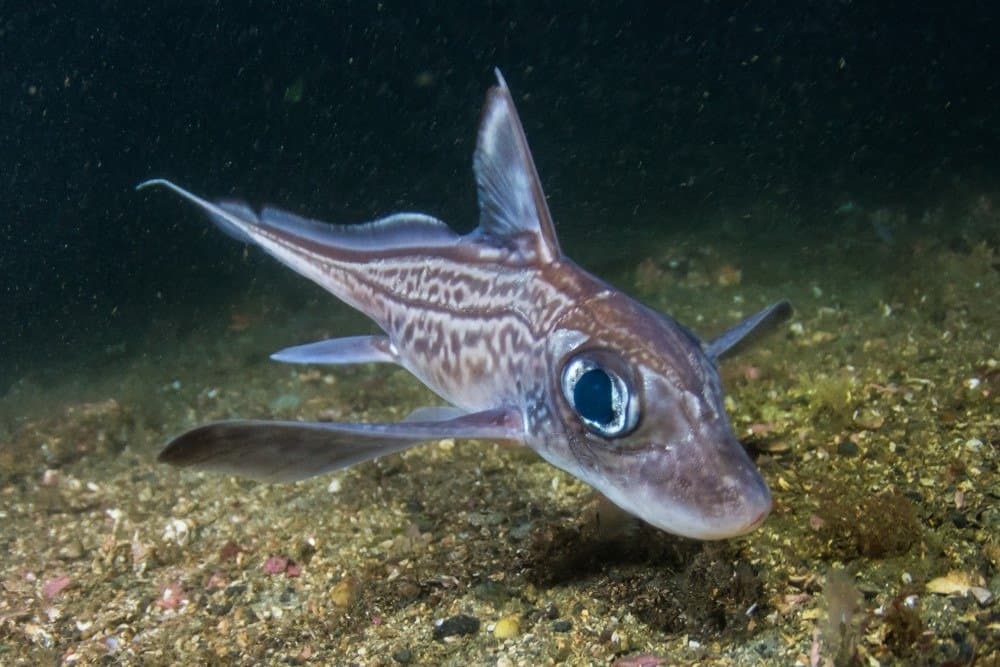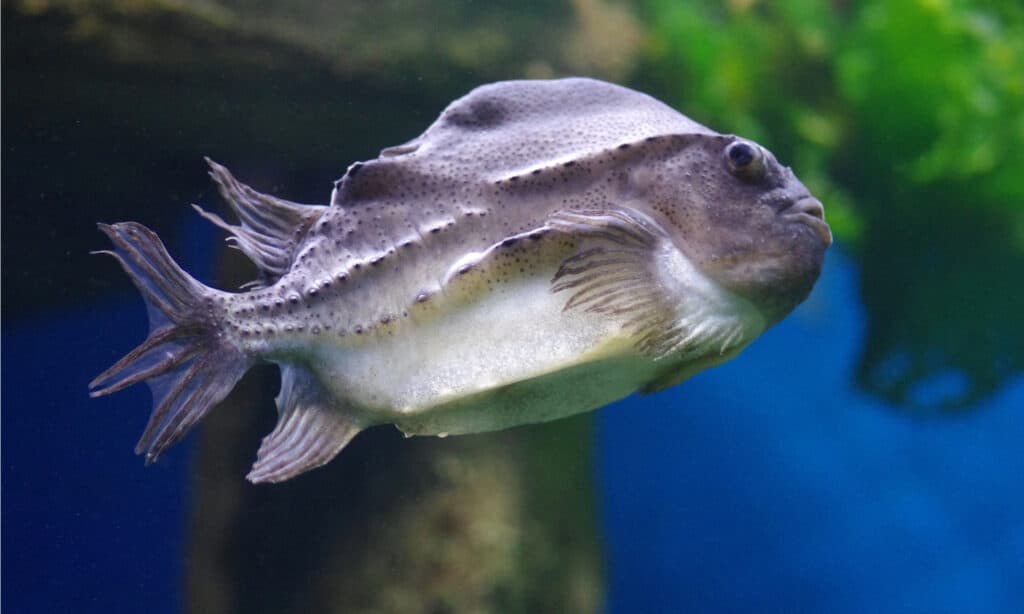Sweden may be famous for its cold weather and gorgeous scenery, but it’s also home to several fascinating fish species. These species are notable for their brilliant colors, odd shapes, or, in one case, their gaping mouths. Read on to discover seven spectacular fish found in Sweden.
1. Opah

Opah s a massive fish, growing to 6.56 feet in length and weighing up to 595 pounds.
©Vanishingfin/Shutterstock.com
One of the most spectacular fish found in Sweden is the opah (Lampris guttatus). This marine fish has a discoid, deep-keeled body adorned with striking colors. Its dorsal region is dark steely blue, fading to green and mingled with silver and purple. Its deep belly is rosy. Both fins and jaws are vermillion, though the eyes are gold-rimmed. Silvery spots cover its body.
The opah swims at depths of up to 1,640 feet, hunting other fishes and invertebrates like squids. It is a massive fish, growing to 6.56 feet in length and weighing up to 595 pounds. It makes a good food fish sold either fresh or frozen.
2. European Eel

The European eel lives in freshwater, spawns in salt water, and then dies.
©Rostislav Stefanek/Shutterstock.com
The European eel (Anguilla anguilla) is a species of fish found in Sweden able to survive in marine, brackish, or freshwater environments. Being catadromous, they mainly inhabit freshwater but move to the ocean to breed. These snakelike fish swim at depths up to nearly 2,300 feet, feeding on various aquatic animals. They are not dangerous to humans.
The European eel grows up to four feet in length and can weigh up to 14.55 pounds. Eel larvae appear as translucent ribbons, transforming into glass eels that can be either transparent or slightly pigmented. After this stage, they become yellow eels, which are larger and brownish-yellow. As they reach sexual maturity, they become silver eels with dark dorsal regions and silvery-white undersides.
3. Garfish

Garfish has an elongated, compressed body.
©Peter Vogt/Shutterstock.com
The garfish (Belone belone) is a needlefish inhabiting the marine and brackish waters off Sweden’s coast. True to its name, it has an elongated, compressed body with a needlelike snout and fins set far back along its body. Its jaws contain a multitude of sharp teeth. This predatory species prefers to remain close to the surface, hunting small fishes. When hooked, it performs spectacular leaps out of the water.
The garfish grows to a maximum length of 3.4 feet and weighs up to 3 pounds. Its body is bluish-green in color with a silvery-grey belly.
4. Shorthorn Sculpin

Despite its spiny head and gill covers, shorthorn sculpin is not venomous.
©RLS Photo/Shutterstock.com
While the shorthorn sculpin (Myoxocephalus scorpius) may not be the most beautiful Swedish fish on this list, it is certainly distinctive. This species’ alternate names include Arctic sculpin, warty sculpin, and short-spined sea scorpion. Its physique is thick and squat with a broad head and a tapering body. Its fins are flared. Despite its spiny head and gill covers, it is not venomous. It prefers the lurk along the rocky bottoms of marine and brackish waters.
The shorthorn sculpin grows to a maximum length of 1.97 feet. In addition to dark mottling, its dorsal region is typically greenish-brown to greyish-brown, though the base color on some individuals may be darker. The undersides of males are cherry-red, while those of females are light orange. Dark bands mark the fins.
5. Rabbit Fish

The rabbit fish grows to a maximum length of 4.9 feet and weighs up to 5.5 pounds.
©Joern_k/Shutterstock.com
The rabbit fish (Chimaera monstrosa) is another fish found in Sweden with a large head and a tapering body. Unlike the shorthorn sculpin, however, its body ends in a whiplike tail. Its name derives from its large, rabbit-like eyes, nostrils, teeth, and overhanging upper jaw. Additionally, it bears a single dorsal spine that is both sharp and mildly venomous.
The rabbit fish grows to a maximum length of 4.9 feet and weighs up to 5.5 pounds. It is a deep-water fish occurring at depths between 130-4,590 feet. Its preferred diet consists of bottom-dwelling invertebrates.
6. Lumpfish

Possible body colors of lumpfish include brown, grey, yellow, olive, and blue.
©Natalia Sidorova/Shutterstock.com
The lumpfish (Cyclopterus lumpus) lives up to its name with a lumpy, ball-shaped body. Three bony tubercules ridge each side of its back. Its large eyes appear to bulge from its head. This marine fish is mostly solitary, swimming at depths up to 2,848 feet. Vendors sell lumpfish eggs as inexpensive caviar and the flesh of adult fish, especially males.
Lumpfish grow up to two feet in length and weigh a maximum of 21 pounds. Possible body colors include brown, grey, yellow, olive, and blue. During the spawning season, the undersides of males turn reddish while females change to bluish-green.
7. Basking Shark

The most striking aspect of the basking shark is its gaping mouth and enormous gill slits.
©Martin Prochazkacz/Shutterstock.com
One of Sweden’s most visually intimidating fish is the basking shark (Cetorhinus maximus). This huge shark is one of the biggest sharks in the world, second only to the immense whale shark. Though reports vary regarding the basking shark’s maximum size, one notable specimen may have been as long as 49.87 feet. Additionally, individuals on a larger scale may weigh up to 10,000 pounds. However, most adults average about 23 feet in length and weigh significantly less.
The most striking aspect of the basking shark may not be its size but its gaping mouth and enormous gill slits. As a filter feeder, it keeps its mouth wide open as it swims to draw in zooplankton. Despite its frightening appearance, the basking shark does not prey on humans.
Up Next:
- Discover 8 Spectacular Fish Found in the Arctic
- Discover 9 Spectacular Fish Found in Turkey
- Discover 7 Spectacular Fish Found in Thailand
The photo featured at the top of this post is © iStock.com/perreten
Thank you for reading! Have some feedback for us? Contact the AZ Animals editorial team.






